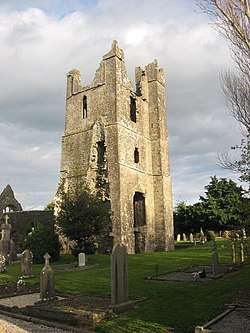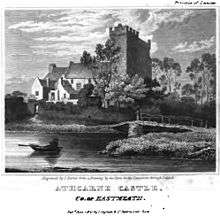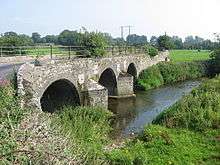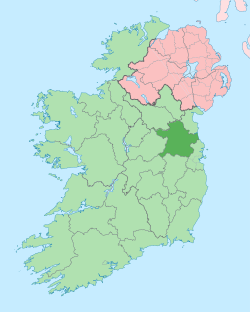Duleek
Duleek (/duːˈliːk/; Irish: Damhliag, meaning "stone house or church[2]") is a village in County Meath, Ireland.
Duleek | |
|---|---|
Village | |
 Tower of St. Mary's Church, Duleek | |
 Duleek Location in Ireland | |
| Coordinates: 53°39′18″N 6°25′00″W | |
| Country | Ireland |
| Province | Leinster |
| County | County Meath |
| Elevation | 34 m (112 ft) |
| Population (2016)[1] | 4,219 |
| Irish Grid Reference | O048687 |
Duleek takes its name from the Irish word daimh liag, meaning house of stones and referring to an early stone-built church, St Cianán’s Church, the ruins of which are still visible in Duleek today.
History

Duleek began as an early Christian monastic settlement. St Patrick established a bishopric here about 450 AD, which he placed in the care of St Cianán on 24 November 489. The place was sacked several times by the Norsemen between 830 and 1149 and was also pillaged by the Normans in 1171. In April 1014 the bodies of Brian Ború and his son lay in state in Duleek on their way to Armagh. The original monastery settlement is reputed to be the place where St. Patrick and several contemporaries spent the winter period while compiling the Seanchas Mór - the first written compiled form of the ancient Brehon Laws of Ireland in the fifth century. The 12th century saw the reconstitution of the original monastery as St Mary's Abbey and the subsumption of the Diocese of Duleek by the Diocese of Meath.
The first Anglo-Norman Lord of Meath, Hugh de Lacy, established a manor and constructed a motte castle at Duleek. About 1180 he granted St Cianán's Church, together with certain lands, to the Augustinians. The churchyard of the now disused Church of Ireland church occupies part of the site of the early monastery. On the opposite side of the village in the town land of Abbeyland close to the river Nanny and Duleek house there are ruins of the Grange of St.Michael. This grange was established in about 1172 by Augustinian monks from Llanthony in Monmouthshire; the lands were granted to them by the De Lacy family. The village’s four crosses and the lime tree on the village green are reminders of Duleek’s links to the struggle between William and James and to wider European unrest at the time of Louis XIV of France. One of the crosses, the Wayward Cross, was however erected in 1601 by Janet Dowdall in memory of her husband, Sir William Bathe of Athcarne Castle outside the village.[3] During World War II, or The Emergency, German bombers accidentally struck the village on 1 January 1941; minor damage was caused and there were no casualties.
A heritage trail, the Duleek Heritage Trail, covers a number of sites in the village centre and was "conceived as a series of stepping stones through the village" and its history.[4]
Transport
Rail

Duleek railway station was opened on 1 August 1850, as part of the line from Drogheda to Navan (and later to Oldcastle). It closed on 1 June 1958.[5] Zinc ore trains from Tara Mines to Dublin Port continue to pass through the station.
Road
Duleek is on the R150 and R152 regional roads. Bus Éireann regional routes serve Duleek from Dublin and Drogheda.[6]
Notable people
- Mick McGowan, darts player, is from the village
- Sir William Bathe of Athcarne Castle (died 1597)
- Frederick Smith, recipient of the Victoria Cross
References
- "Small Area Population Statistics - Settlement - Duleek". Census 2016. Central Statistics Office. April 2016. Retrieved 16 February 2020.
- Irish Local Names Explained by P.W. Joyce Archived 25 July 2008 at the Wayback Machine
- Duleek Heritage Trail, Meath Tourism - Ireland, Accommodation, Holidays, Vacations, Golf, Fishing, Castles, Maps
- "Stepping Stones to Duleek's Past - Duleek Heritage Trail" (PDF). meathtourism.ie. Archived from the original (PDF) on 15 March 2004.
- "Duleek station" (PDF). Railscot - Irish Railways. Retrieved 5 September 2007.
- "Regional Services by County". Bus Éireann. Retrieved 10 July 2019.
